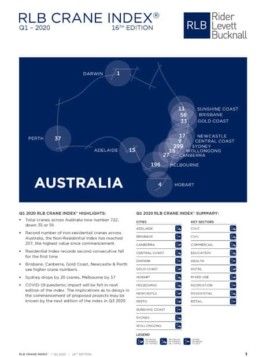According to today’s release of the Q1 2020 RLB Crane Index®️, there are currently 772 cranes working on key projects across Australia as construction is deemed an essential service during the COVID-19 crisis by all governments (Federal and State). Construction contributes 9% to the total Australian economy.
Current disruption will impact the industry
Domenic Schiafone, the Rider Levett Bucknall (RLB) Oceania Director of Research and Development said, ‘The current uncertainties surrounding the COVID-19 pandemic will impact the industry for the remainder of 2020. Any shutdown of the industry will be felt for far longer than the shutdown period, as maintaining both the workforce and supply chains during a closedown will be difficult. The industry has never seen this type of disruption in generations, and the speed of mobilisation is an unknown.’
Total cranes in Australia now number 722, down 35 cranes, or 5%, from 757 in Q3 2019, our last edition. Building work done across the country was down by 4% for 2019 in Chain Volume Measures (CVM). Residential activity fell by 8% and non-residential was up by 5%.
Non-residential records its highest value since 2012
These results reflect the movements in the current crane index numbers. The last six months has seen a shift between the sectors of the RLB Crane Index®️. The non-residential index has recorded its highest value since the introduction of the index in Q3 2012. A record 238 non-residential cranes now can be seen across the country adding important assets for all Australians in the commercial, education, health and infrastructure sectors.
Projects in design phase put on hold
Residential cranes had the largest fall with 37. Residential cranes now account for 66% of all cranes observed, down from a record high of 86% in Q3 2017.
Domenic continued, ‘You could say that project work from a pre-contract point of view is frozen, due to there being (at this stage) no end to the restrictions put into place. Projects across most sectors, in the design phase, have virtually been put on hold.’
‘Pre COVID-19, the general feeling was one of optimism as new projects that were planned would come on stream to replace some of the activity coming to an end, and while not at record levels, 2020 volumes would be comparatively near or above the 10-year average across the country,’ he said.
‘However, this has tapered off from late last year and is now forecast to drop more rapidly,’ he added.
Sydney leads crane count
Looking around the country, Sydney continues to be the main driver of the crane count. Of the 772 cranes sighted across Australia, 299 were in Sydney, 196 in Melbourne, 58 in Brisbane, 37 in Perth, 33 on the Gold Coast, 27 in Canberra, 15 in Adelaide, 15 in Wollongong, 11 in the Sunshine Coast, 17 in Newcastle, 4 in Hobart and 1 in Darwin.
Both Melbourne and Sydney saw falls in crane numbers but in different sectors. Melbourne suffered falls in residential cranes (from 149 to 122) but Sydney saw falls in both commercial (from 44 to 32) and education cranes (from 12 to 3).
According to the RLB Crane Index®️, five cities observed more cranes on the horizon (Brisbane, Canberra, Newcastle, Perth and the Gold Coast) and six had lower numbers (Adelaide, Central Coast, Hobart, Melbourne, Sydney and Wollongong). Two cities remained the same (Darwin and the Sunshine Coast).
The future is uncertain
Matthew Harris, Managing Director of RLB in NSW said, ‘The outlook is uncertain, as we all know we could be living with these restrictions for some time. Some property developers, investors and listed entities are reluctant to push ahead with any new projects.’
‘Both Federal and State Governments have indicated they wish to move ahead with new building and infrastructure projects given they want to keep the industry going. It remains to be seen how quickly this will happen and to what levels,’ he concluded.
FURTHER INFORMATION:



